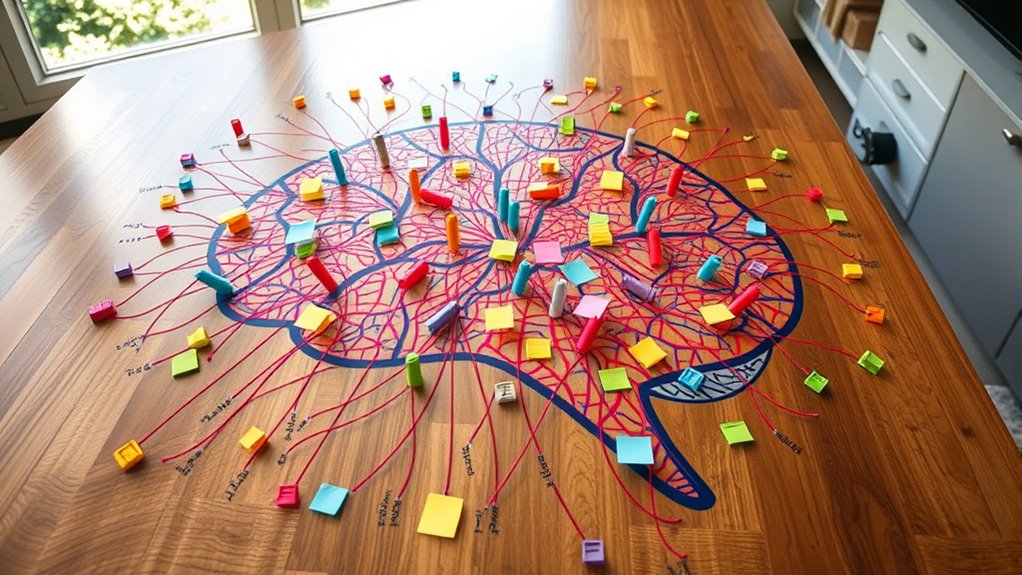Mind mapping is a visual thinking tool that helps you organize ideas, solve problems, and boost creativity. By connecting concepts with images, colors, and hierarchical structures, you can see relationships clearly and generate new solutions. It encourages spontaneous thinking, breaks linear patterns, and makes complex information more memorable. As you explore its potential, you’ll discover how it can transform your approach to tackling challenges and planning creatively—so keep exploring to unleash its full benefits.
Key Takeaways
- Mind maps organize complex problems hierarchically, helping identify key issues and explore related subtopics visually.
- Visual elements like colors, images, and symbols enhance understanding, memory, and pattern recognition in problem-solving.
- Centralized maps focus attention on core problems, allowing systematic breakdown into manageable parts for analysis.
- Mind mapping promotes creative thinking by facilitating spontaneous associations and divergent idea generation.
- Future technologies like AR, VR, and AI further enhance problem visualization, collaboration, and insight discovery.
The Origins and Evolution of Mind Maps
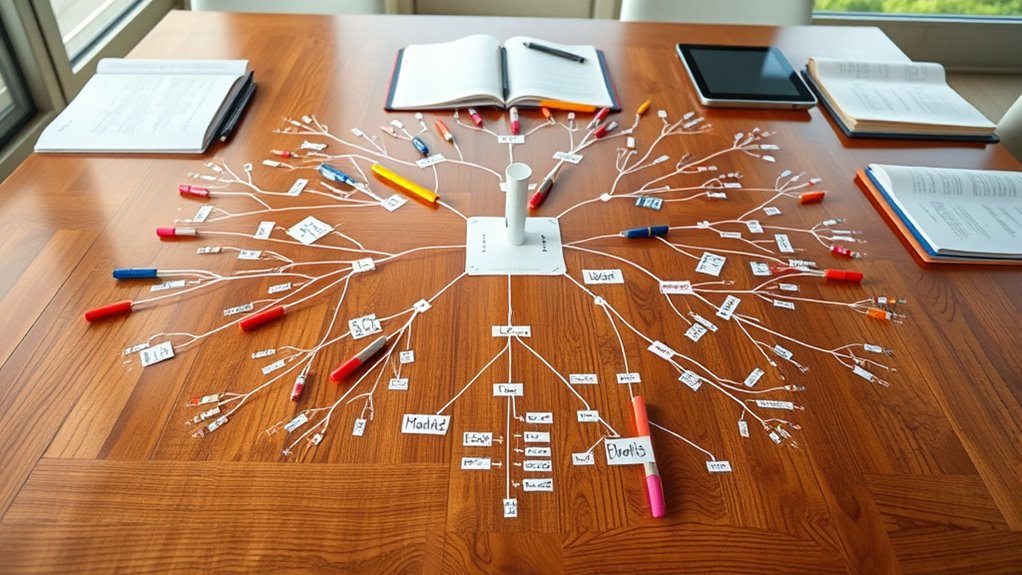
The origins of mind maps trace back over two millennia, beginning with the work of Porphyry of Tyros around 300 AD. He created a visual diagram to show relationships between concepts, building on Aristotle’s categories. This early form aimed to support learning and problem-solving by organizing ideas visually. During the 13th and 14th centuries, Ramon Llull used similar techniques to enhance comprehension and memory. These methods helped users connect ideas clearly and efficiently. In the 1950s and 1960s, semantic networks emerged, illustrating how concepts relate, further shaping modern mind mapping. Tony Buzan popularized the term in the late 20th century, emphasizing its natural fit with how we think and learn. Over time, mind maps evolved from simple diagrams to powerful tools across many disciplines. Additionally, the development of visual thinking techniques has further expanded the application of mind maps in various fields.
How Visual Thinking Enhances Creativity
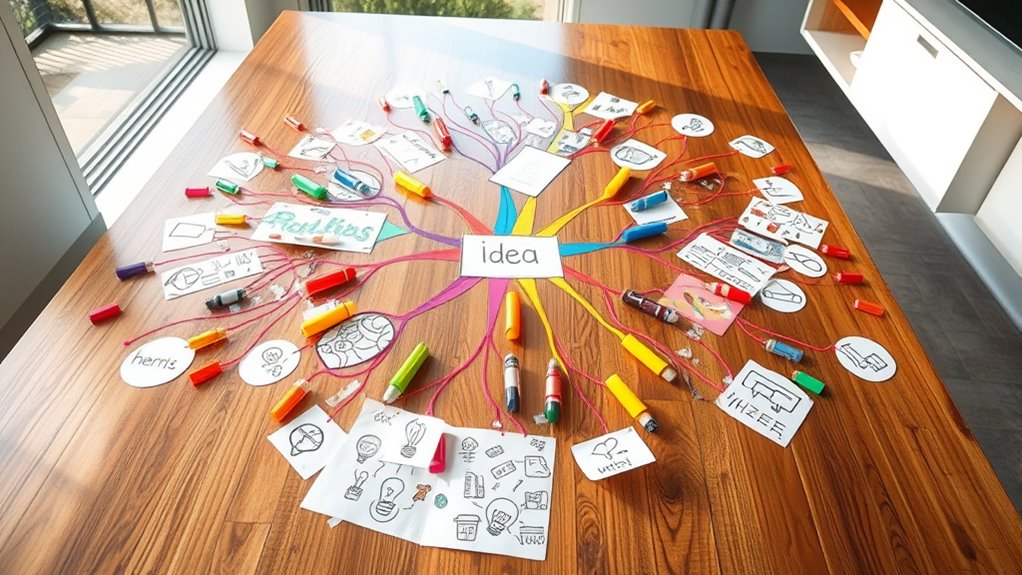
Visual thinking opens your creativity by enabling spontaneous associations and free-flowing idea generation. When you use visual tools like mind maps, you break free from linear thinking, allowing multiple ideas to branch out naturally. This stimulates divergent thinking, which is essential for innovation. Visual stimuli activate the brain’s spatial areas, sparking insight and novel connections. By externalizing your thoughts with images and keywords, you reduce mental overload, freeing up cognitive resources for creative exploration. You can also reframe problems by visualizing relationships, revealing hidden patterns and new perspectives. Engaging with visuals makes your thinking more dynamic and accessible, encouraging collaboration and diverse viewpoints. Incorporating crochet styles for locs into your visual thinking process can inspire innovative design ideas and creative problem-solving approaches. Additionally, integrating creative techniques can further boost your ability to generate and refine ideas effectively. Moreover, understanding how AI tools can assist in content creation opens new avenues for enhancing your visual thinking and idea development. Being aware of divergent thinking techniques helps diversify your problem-solving strategies and fosters original solutions. Overall, visual thinking enhances your ability to generate, develop, and refine creative ideas more effectively.
Using Mind Maps to Tackle Complex Problems
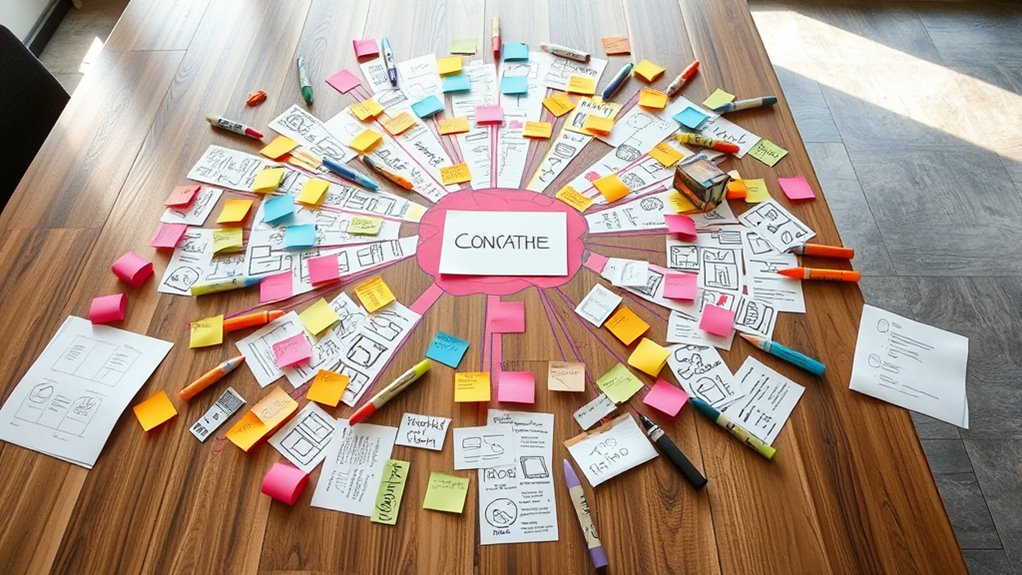
When tackling complex problems, organizing your thoughts with mind maps can substantially improve clarity and focus. Begin by centralizing the main issue to keep your attention on the core. Develop main branches that represent key aspects or causes, then add sub-branches to explore detailed factors and root causes. Use hierarchical or radiant structures to organize components clearly, and visually separate elements to ease mental processing. To generate solutions, create a separate mind map branching out from the problem, including practical ideas and strategies, with pros and cons for evaluation. Use keywords, colors, and images to enhance understanding and memory. Breaking down problems into smaller maps reduces overload, helping you analyze each part systematically and develop manageable, effective solutions. Additionally, understanding the types of cookies used in digital tools can help you manage your privacy while working on problem-solving activities online.
Designing Effective Mind Maps for Clarity
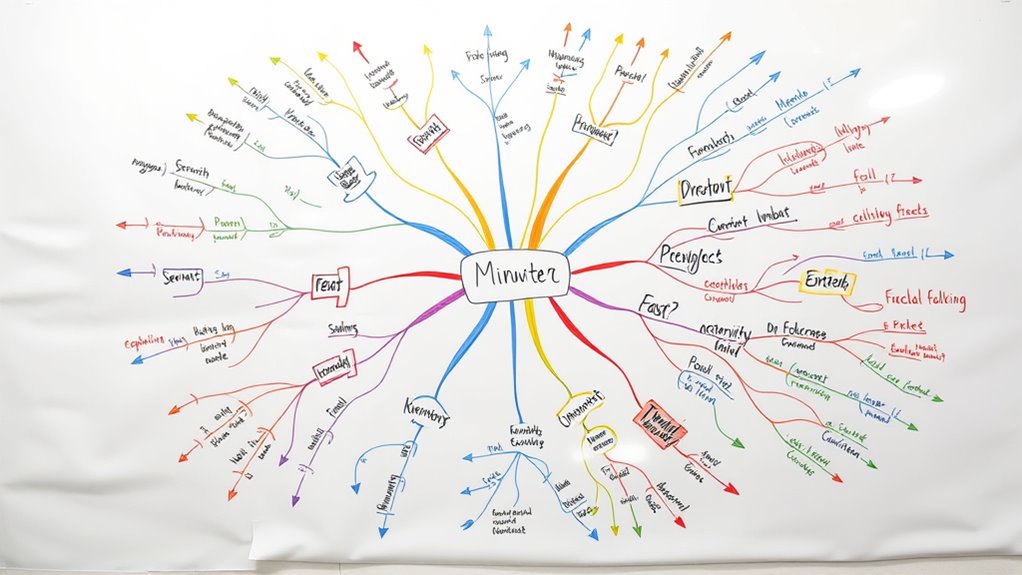
Designing effective mind maps for clarity focuses on structuring your ideas so they’re easy to understand and navigate. Start with a clear central idea, making it the focal point. Organize related information hierarchically to show relationships and flow. Use visual elements like colors, icons, and images to highlight key points and differentiate categories. Maintain ample white space to prevent clutter, making the map visually appealing and easier to interpret. Highlight important ideas through size, color, or placement, emphasizing their relevance. Arrange your map logically, allowing for smooth navigation. Remember to refine your map iteratively, ensuring clarity and relevance as your ideas evolve. Keep the design flexible, allowing updates and adjustments to improve understanding. Additionally, incorporating necessary cookies can help maintain basic functionality and improve user experience as your mind map develops. Incorporating visual tools aligns with mind mapping principles, enhancing clarity and recall. Using visual elements like icons and images can further clarify relationships and make complex ideas more accessible. Leveraging remote hackathons and digital collaboration tools can also facilitate diverse perspectives and innovative solutions during your mind mapping process. Recognizing the importance of hydrogen fuel cells in clean energy transitions, you can also incorporate related concepts into your map to visualize their environmental benefits and future potential.
Practical Applications Across Different Fields
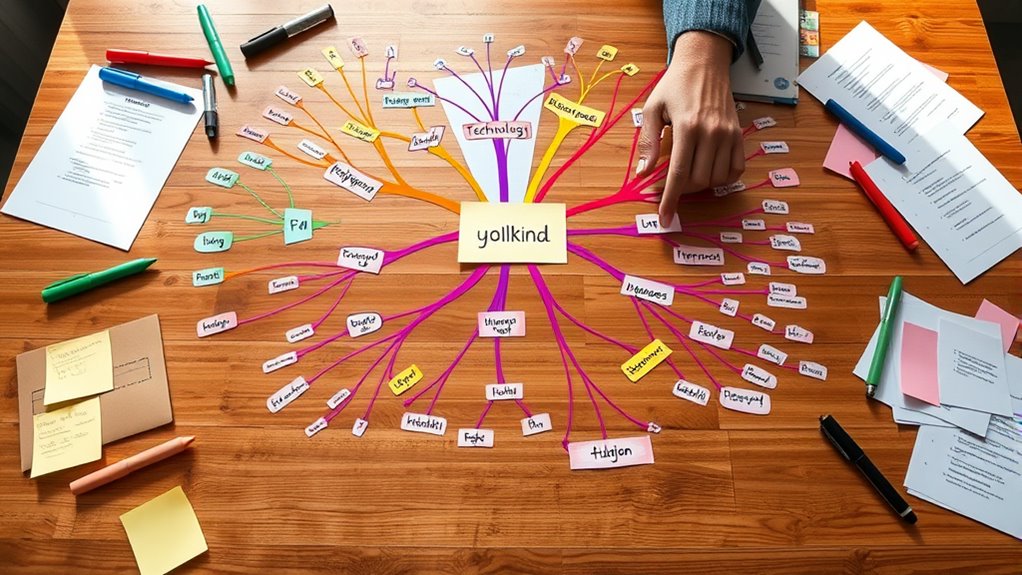
Mind mapping proves to be a versatile tool across various fields, helping professionals organize and analyze information efficiently. In business and project management, it enhances strategic planning by visually outlining goals and tasks, supports collaborative brainstorming, and breaks down complex projects into manageable parts. It also improves meeting productivity by structuring agendas and follow-ups visually and aids root cause analysis through cause-and-effect diagrams like fishbone maps. In education, it helps students take notes, organize ideas, and design lesson plans, boosting memory and understanding. Healthcare professionals use it to map symptoms, plan treatments, and share care strategies, while creatives generate ideas, organize designs, and track project progress. For personal growth, it visually breaks down goals, aids decision-making, and supports habit tracking, boosting clarity and focus. Additionally, integrating water-related concepts, such as hydrotherapy and aquatic exercises, can enhance problem-solving by promoting relaxation and mental clarity. Recognizing the role of sports and leisure activities can also contribute to mental well-being and creativity, providing a balanced approach to problem-solving. Moreover, understanding resources and tools available in various fields, including legal and health sectors, can further optimize problem-solving strategies. Exploring educational tools and toys, like those that develop cognitive and fine motor skills, can also support the development of creative thinking and problem-solving abilities from an early age. Incorporating structured approaches like mind mapping can further streamline complex decision-making processes and improve overall effectiveness.
Tips for Maximizing the Benefits of Mind Mapping
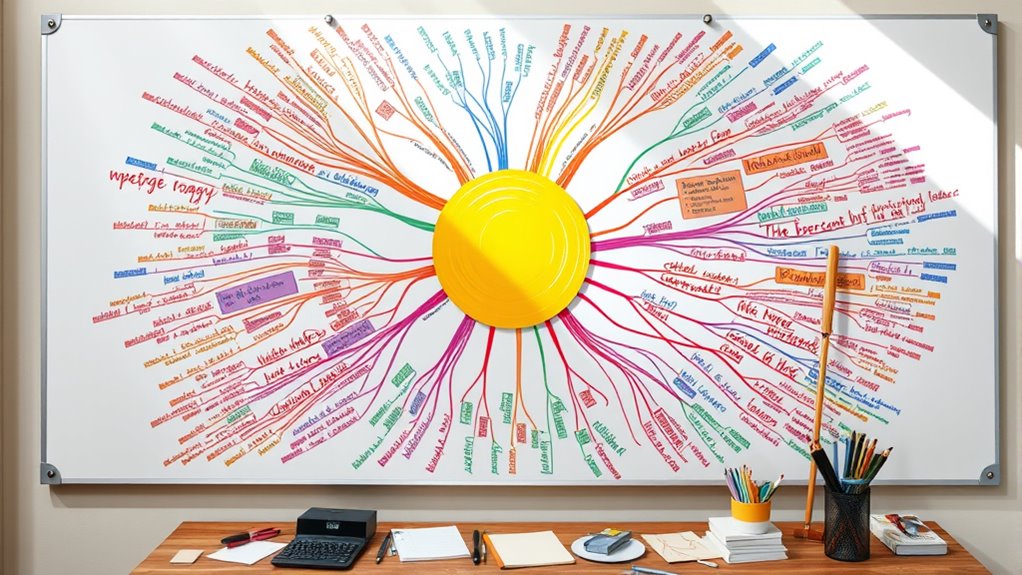
Maximizing the benefits of mind mapping starts with setting it up effectively. Begin with a clear central idea, then branch out to subtopics logically. Use color coding to distinguish main themes from details, which boosts visual clarity. Incorporate images and symbols to make your map more memorable and engaging. Maintain a consistent structure across your map so that information remains easy to interpret. Digital tools can help you collaborate seamlessly and make edits effortlessly. Regularly review and update your mind map to reflect new insights or changes. By organizing ideas thoughtfully and leveraging visuals, you enhance understanding and retention. Incorporating visual learning tools can further improve your ability to process and remember information. These strategies ensure your mind maps serve as powerful tools for problem-solving, creativity, and effective planning.
The Future of Visual Problem-Solving Techniques
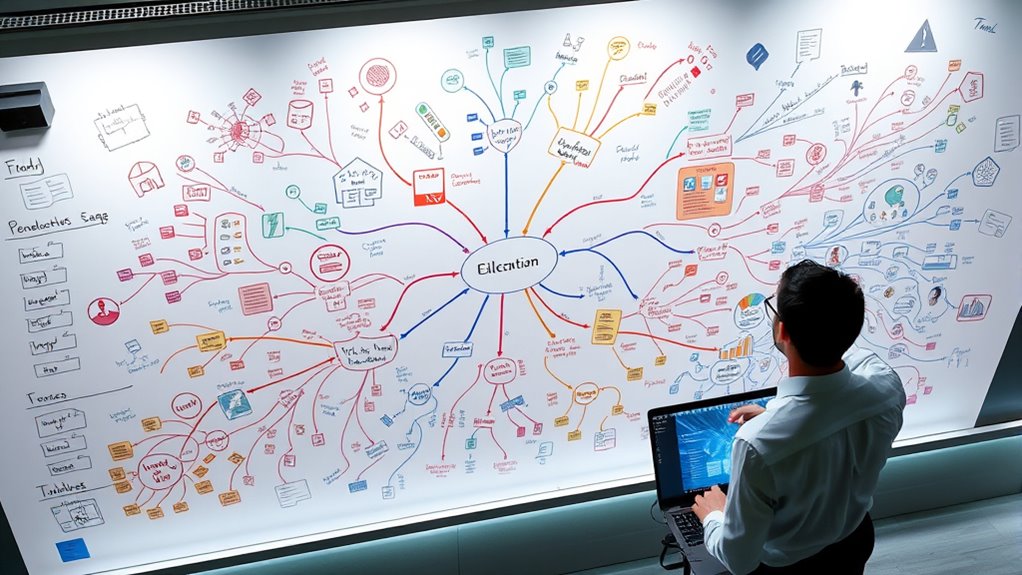
How will emerging technologies transform the way you approach visual problem-solving in the future? Augmented Reality (AR) will let you interact with virtual models, making complex problems easier to understand and solve. Virtual Reality (VR) will enable seamless global collaboration, improving communication and idea sharing. Big Data analytics will provide insights from massive datasets, supporting more informed decisions. AI-powered pattern recognition will help you spot hidden trends in data, revealing solutions beyond human perception. Quantum computing will handle intricate calculations that are currently impossible, accelerating problem-solving. These innovations will integrate seamlessly with evolving techniques like visual semantic integration and real-time feedback, making problem-solving more dynamic, inclusive, and efficient. Additionally, staying informed about current events in Indonesia can inspire innovative solutions by understanding local challenges and opportunities. The future promises smarter, more immersive tools to enhance your creative and analytical thinking, while advances in visual data processing will further improve the clarity and accuracy of your insights. Furthermore, understanding the AI bifurcation can help you anticipate how artificial intelligence might influence these emerging tools and techniques, ensuring you remain adaptable in this rapidly evolving landscape. Incorporating advanced visualization technologies will also enable more intuitive comprehension of complex data, further transforming problem-solving approaches.
Frequently Asked Questions
How Do I Start Creating a Mind Map for a New Project?
To start creating a mind map for a new project, first define your main goal or objective, placing it at the center. Identify key stakeholders and essential resources like budget and tools. Then, create branches for major project phases or components, adding sub-branches for tasks and ideas. Use colors, keywords, and images to enhance clarity. Keep it flexible, updating as your project evolves and new insights emerge.
What Tools or Software Can I Use for Digital Mind Mapping?
Imagine your ideas blooming like a vibrant tree, each branch representing a different thought. To bring this to life digitally, you can use tools like Miro and MindMeister, which let you collaborate and expand your map in real time. Coggle tracks changes easily, while Canva offers customizable templates. For free options, try MindMup or Gitmind. These tools help you visualize, organize, and develop your project effortlessly.
Can Mind Maps Help Improve Team Collaboration Remotely?
Yes, mind maps can substantially improve your remote team’s collaboration. They provide a clear visual of complex information, making it easier for everyone to understand and stay aligned. With real-time updates and cloud access, your team can work together asynchronously, share ideas, and prioritize tasks efficiently. Mind maps foster engagement, encourage participation, and help visualize connections, ultimately enhancing communication, coordination, and overall project success across distances.
How Often Should I Update or Revise My Mind Maps?
You wonder how often you should update or revise your mind maps. It’s best to do so regularly, especially when new information arises or your understanding deepens. The frequency depends on how complex your project is, but updating keeps your maps relevant and useful. Don’t wait too long—refresh them often to reflect your latest insights. This habit guarantees your mind maps stay dynamic, helping you learn and solve problems more effectively.
Are There Common Mistakes to Avoid When Designing a Mind Map?
Avoiding common design mistakes is like steering a ship clear of rocks—you want smooth sailing. You should start with a clear central image and purpose, or your map can drift aimlessly. Keep branches logical, use color for clarity, and don’t overcrowd with too many words. Focus on content, not aesthetics. Regularly review and revise your map to stay on course, and consider collaborating for fresh ideas.
Conclusion
Imagine your mind as a vast, vibrant garden, and mind mapping as the guiding sun that helps your ideas bloom. By harnessing this visual thinking tool, you unleash a world where creativity flows like a river and complex problems unravel like knots in a gentle breeze. Embrace mind mapping, and watch your thoughts flourish into clarity and innovation—transforming chaos into a masterpiece of understanding and possibility. Your journey to problem-solving just got a whole lot brighter.
